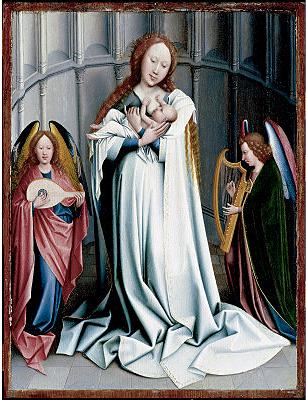Follower of Robert Campin (also known as the Master of
Flemalle)
Early Netherlandish, c. 1375-1444VIRGIN AND CHILD IN AN APSE
SN 196, oil and tempera on panel
From "The Pages"
ARTIST:
Campin worked in the city of Tournai, in what is now Belgium, but was prosperous and well
known outside of Tournai. He was associated with and influenced both Rogier van der Weyden
and Jacques Daret. They may have been apprenticed to him, but van der Weyden was more
likely a master in his own right before becoming associated with Campin. Little is known
about the Tournai painters, but it is with increasing certainty that Campin is identified
as the Master of Flemalle. (Suggested reading: Grove, The Dictionary of Art, Vol 20, The
Master of Flemalle.) Another of his best known works is the Merode Altarpiece in the
Cloisters in New York City. Campin is one of the most famous Flemish painters of the 15th
century.
SUBJECT:
The painting shows a standing Madonna nursing the Infant who is held tenderly in her arms.
She is clothed in a white dress and blue robe, both of which are delicately edged in gold.
The Virgin is flanked by two musical angels, one with a lute, the other with a harp. The
Virgin's arms are crossed, symbolic of adoration. (This gesture can be found in other
paintings in the Ringling collection.) She is standing in an apse which has nine fluted
columns. This may be an iconographic symbol for the nine choirs of angels. |
|
 |
PAINTING:
This is one of at least thirty copies of the original painting, one of Campin’s most
admired works, which is now lost. [Other examples in public collections may be found in
the Metropolitan Museum in New York and the National Gallery In London. The original
painting is thought to have been painted about 1425, while the Ringling copy has been
determined (by dating of the wood panel) to have been painted in 1539.]
The artist uses a strong, sculptural style, placing a religious theme in a setting which
should be very familiar to the contemporary viewer: the interior of a Gothic cathedral. A
gentle curve in the apse itself suggests depth, but it is still a shallow space. Later
interiors by the artist show a better depiction of spatial depth. There is an overall
flatness and a precise linear quality to this painting, probably due to the fact that it
was painted early in the artist's career. Great attention has been paid to surface detail,
but there is no real feeling of a body beneath the draperies, which are handled to make
the Virgin appear to be floating. The face is idealized; only the tenderness of expression
gives her the human connection. Angels playing the lute and harp glorify Her holiness with
song in accordance with the Book of Psalms.
The oval face of the Virgin, the rounded, bald head of the Infant, and the sculptured
robes falling in a circle around the Madonna's feet are all features which make this
painting attributable to Robert Campin.
There is some loss of paint in the areas of gold (decoration of the robe and the halo),
but it is otherwise in good condition.
HISTORIC CONTEXT:
This particular image was popular in the 15th and early 16th centuries as a votive symbol.
A cult of followers of the Swedish St. Birgitta developed among the upper class women of
that time. St. Birgitta had visions of the Virgin, dressed in white, in a cave. She wrote
a series of prayers for worship, and promulgated a theory that contemplation of iconic
images could produce miraculous powers. The numerous copies of this painting attest to the
popularity of this cult.
Museum Label:
Virgin and Child in an Apse
c. 1539
Artist: Follower of Robert Campin, also called the Master of Flemalle
(Campin was Flemish, c. 1375/79-1444, active in Tournai)
Oil and tempera on panel, 17 1/4 x 13 in. (43.8 x 33 cm)
This panel is one of the finest surviving copies of one of the most admired pictures, now
lost, by Robert Campin, the Tournai painter who is also known as the Master of Flemalle.
Of particular reference to his style are the subtle effects of brushwork and illusionism
and the manner in which the light illuminates the drapery, hair, and skin of the Virgin
and angels. During the 15th century, several famous pictures were copied because they were
believed to possess miraculous powers. The presentation of the Madonna and angels in an
apse is based upon a medieval metaphor of the Church as the image of heaven.
Bequest of John Ringling, 1936, SN196
ringlingdocents.org
|